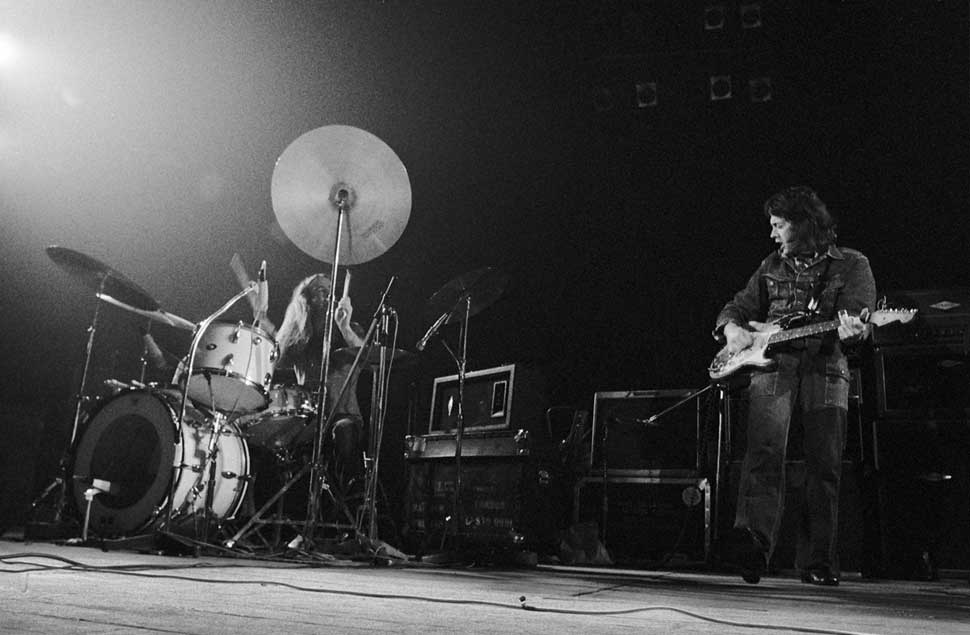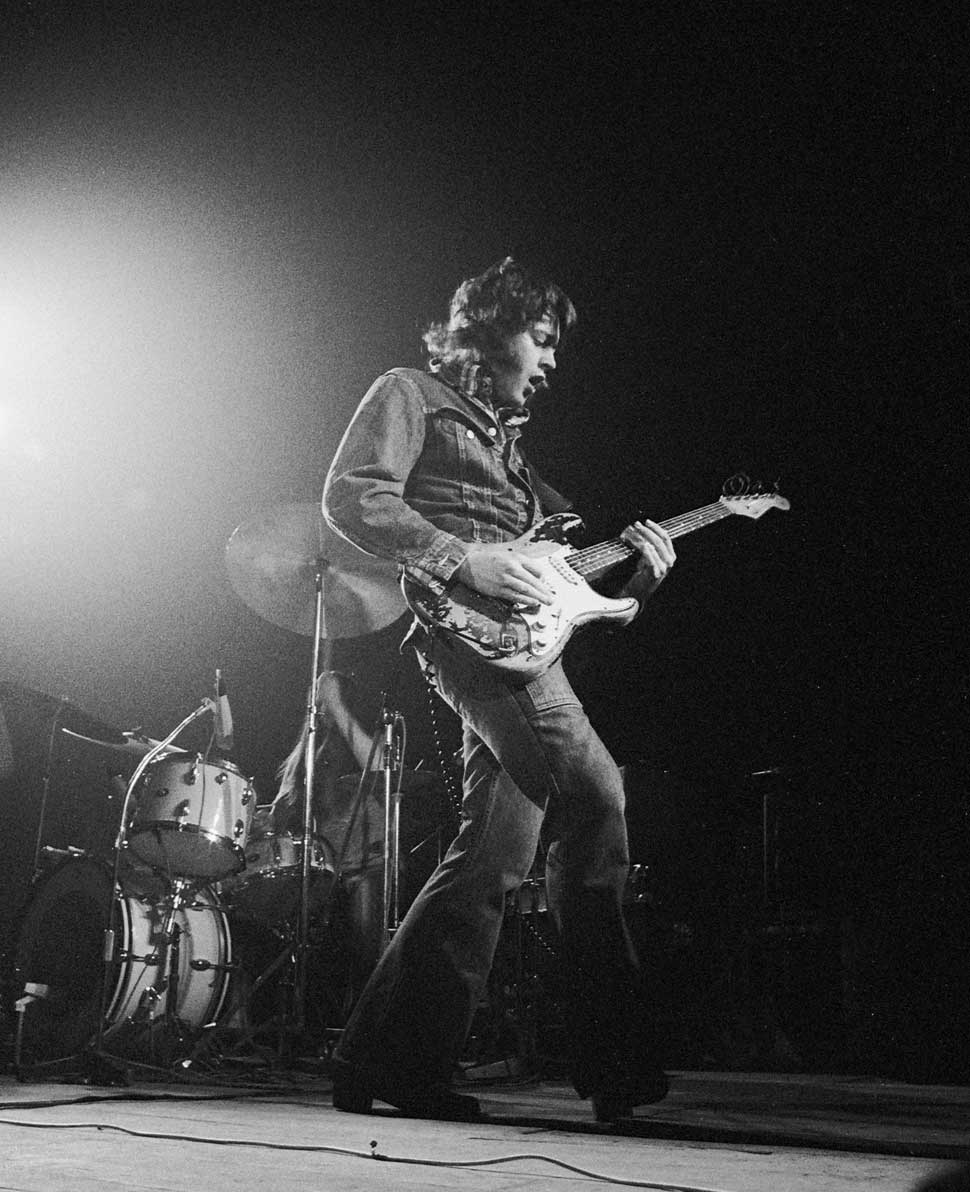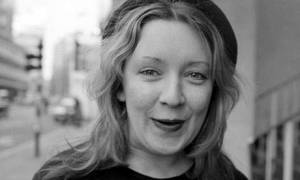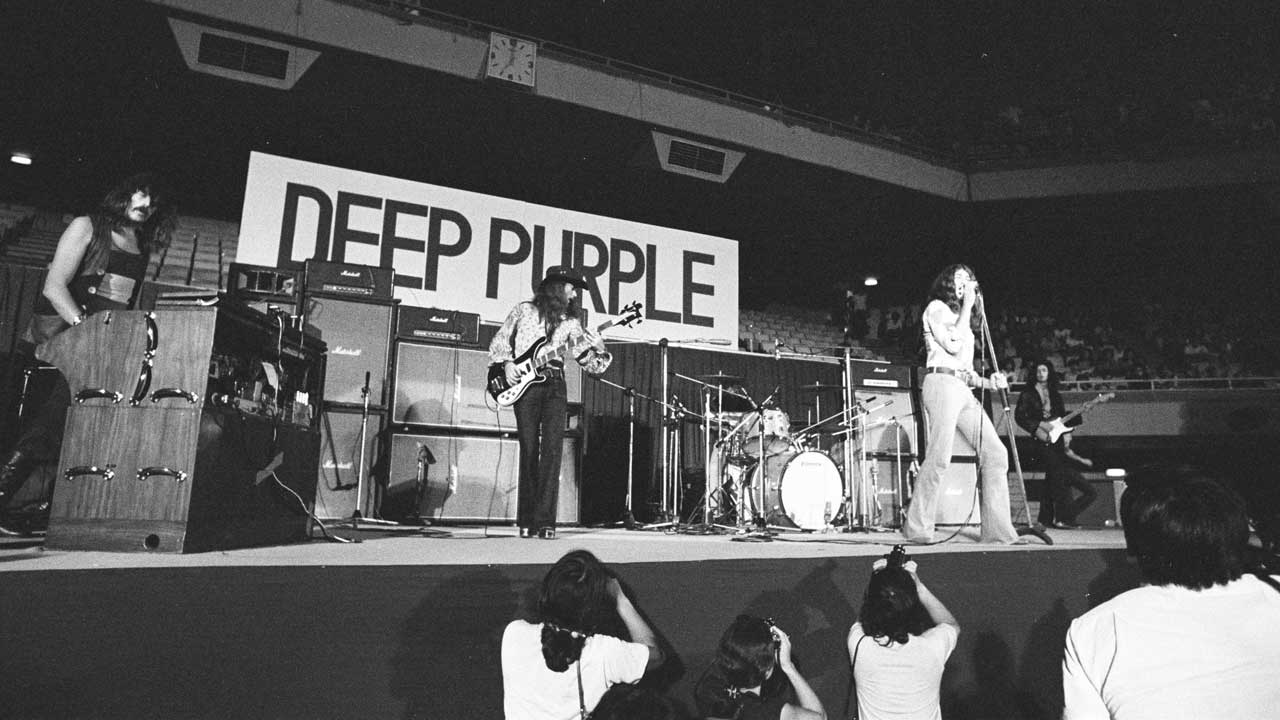"The police car rolled down a nearby slipway into the river": Wild times on the road on Rory Gallagher's most iconic tour
Known for his musical integrity and down-to-earth approach, Rory Gallagher was the workingman's guitarist, and Irish Tour '74 his defining statement

In 2005, to mark the 10th anniversary of Rory Gallagher's death, late Classic Rock writer Carol Clerk spoke to Gallagher's bandmates and management about the guitarist's landmark 1974 Irish tour, which famously took in both sides of the sectarian divide and produced an acclaimed movie.
For Rory Gallagher, it was only ever about the music. He was an explosive performer, a riveting entertainer, but he had no interest in flaunting or exploiting his wealth and fame. He refused to release singles, he never learned to drive, he dressed in denim, he lived modestly in London, he was famous for his gentle and polite personality, and he made time for his fans – always.
As Gary Moore noted: “He was such a purist. He wouldn’t sell himself out. How many people do you know in the music business who would take that kind of stand? If there hadn’t been people like Rory around to set that example, it would probably spell the end of quality music.”
Rory was a born guitarist, a natural. But he never stopped listening, learning, perfecting and personalising the age-old techniques of the blues in its infinite varieties, electric and acoustic. Equally, there was nothing casual about his relationships with country & western, folk, jazz, boogie, rock’n’roll and hard-line, no-nonsense rifferama.
When Rory died in 1995, having sold more than 30 million albums, he left a body of work that is revered the world over. He passed away in hospital on June 14, due to complications arising from a liver transplant. He was 47. He liked a drink, but he was strongly opposed to recreational drugs. It’s ironic, therefore, that his illness was brought about primarily by prescription pills.
It was an untimely death, marked a decade later by the release of the double-CD compilation Big Guns, a major exhibition in Gallagher’s home town of Cork, and a spread of commemorative gigs performed by many of his tribute bands.
Now is as good a time as any to revisit the albums, the videos and the DVDs, and to relive some of the most exquisite guitar work recorded by anyone.
Sign up below to get the latest from Classic Rock, plus exclusive special offers, direct to your inbox!

The jewel in the crown of Rory’s recorded legacy is inarguably Irish Tour ‘74, released as a double live album and a film documentary. It remains his most popular accomplishment.

“Yeah, they were happy days,” says Gerry McAvoy, Gallagher’s long-serving bass player, looking back on the celebrated journey. “It was very close to the best tour we ever did. Rory was at the top of his game, totally on form. Things were peaking everywhere. He’d won the Melody Maker Best Guitarist poll.
"He was feeling so much at ease. He’d been in control of his own destiny since 1971 – there was no formal management, and the record company were happy to go along with him doing his own thing. Everything was tickety-boo. The set we were playing stands up 100 per cent against any of our others, before or after."
“Rory was a very easy person to tour with,” McAvoy continues. “He was the boss on stage; I always regarded myself as a sideman, and that was easy to accept ‘cos I was enjoying myself as much as he was. We were the band, and Rory was The Man, which makes for a better show ‘cos there’s a certain control there. It doesn’t have to be dominant, but it has to be respected. Socially, though, it was Rory and the guys all together.”

McAvoy, from Belfast, had entered the picture after the demise of Gallagher’s power trio Taste in 1970 – an event which also enabled Rory to break free from an unhappy management set-up.
By the time of the ’74 Irish tour (which actually opened in Belfast a day or two after Christmas 1973), Rory had brought in drummer Rod De’Ath and pianist Lou Martin, both from the blues band Killing Floor, and created a “cottage industry” of trusted family members and close friends to guide his career.
Chief among these were right-hand man and backline roadie Tom O’Driscoll, Rory’s best friend from Ireland, and Donal Gallagher, his brother and “chief cook and bottle-washer”.
Donal was perpetually harassed, always sleepless and unfathomably good-natured. In the early 70s he assumed all the responsibilities of the road manager, supervised the equipment and the stage, humped the gear, mixed the live sound, and co-managed the band with Rory and his agent David Oddie. Donal was also Rory’s driver, his trouble-shooter, and an unusually well-meaning PR who saw to it that journalists and fans alike received time with Rory in the dressing room and were sorted for a safe trip home.
On the Irish Tour ’74, Donal had even more to think about. It was all being filmed by director Tony Palmer for an Omnibus TV special, and Donal found himself having to liaise between Rory and the film crew.
The shows were supposed to be audio-recorded by a mobile studio but it didn’t arrive until the end of the tour, forcing Donal to record straight from the mixing desk most nights. The studio truck’s delay was in part due to the violent troubles going on in Northern Ireland at the time, which in turn added to the tensions surrounding the tour.
But the Belfast crowds were euphoric. Starved of live music, they gave a hero’s welcome to Rory, who insisted on gigging there regularly no matter how perilous the circumstances. In his early days, he had lived in Belfast for a while, and the city’s great love and respect for him continues today.
“Because of ‘the troubles’, the Belfast audiences were always something special,” McAvoy recalls.
“Rory never felt fear,” Donal says. “We did have one or two incidents in Northern Ireland on other occasions, but it was generally kind of felt that Rory was untouchable. I’ve always been conscious not to accentuate the negative, but the Ulster Hall… Bedford St wasn’t called ‘Bomb Alley’ for nothing.
“There was a huge soft spot for Belfast with Rory,” Donal continues. “We were home-from-home. You knew he was relaxed and enjoying himself. And those particular shows at the Ulster Hall were very hard to even compare with any others – to have the whole excitement of all the kids in Belfast, and the adults as well, just celebrating, effectively, and rocking out.”

Rory Gallagher’s policy of putting music above all else, plus the social and political background to the tour, led to tensions with director Tony Palmer. Rory wanted the documentary to focus on the gigs.
“Tony had shot some of the uglier side of Belfast and the north, and Rory felt it was not about that,” Donal explains. “He wasn’t comfortable. I don’t think they fell out, but things became slightly strained. Tony Palmer used to say when I came into the room: ‘Oh, the friendly Gallagher.’
“Tony was directing what he wanted his documentary to portray, and Rory would be: ‘All I want you to do, Tony, is film the band. All the other stuff showing a politically divided Ireland, a holy Ireland – forget it. This is me at home in my stamping ground.’
“Gerry, Rod and Lou, and myself to a large extent, didn’t even know if we were meant to be in the picture. It was hard to be natural; people weren’t used to cameras. I certainly wasn’t.”
McAvoy: “Initially it was imposing. But Tony did it in such a way that after a while you didn’t notice the cameras.
Moving on to Dublin, the group enjoyed a wonderful highlight, which unfortunately was not immortalised on film.
“One memory, one special one,” McAvoy remembers. “We’d played the Carlton Cinema, and we were chilling out in the lounge of the Gresham Hotel, when Luke Kelly, Barney McKenna and John Sheehan of The Dubliners came in with their instruments.”
“Rory and I were thrilled to bits,” Donal recalls. “At that time, what I’d play in the car or the van was The Dubliners’ album Pure And Simple and, prior to that, Revolution.
“I got the acoustic and mandolins out of the van. The night staff were used to us staying there, and the trays of pints and sandwiches kept coming. Tony Palmer and Les Young, the cameraman, went out and got cameras. But Rory didn’t want any lights put on it. He felt it would damage the session.”
The jam session was filmed unlit – and unsuccessfully.
In Cork, the mobile recording truck turned up at last. Donal: “There were excuses; they couldn’t get insurance, they couldn’t do this, they couldn’t do that.”
They did, however, escape the “punishment” meted out to Tony Palmer by Donal, Gerry McAvoy and promoter Jim Aiken’s assistant Micky Connolly.
“We had these rubber masks we’d bought in novelty shops in America,” Donal recalls. “We were staying at a hotel in MacCurtain St, Cork, and we were making merry through the night. Micky decided that Tony Palmer deserved taking down a peg or two.
“We put these masks on and went into Tony’s room. He was fast asleep. Micky woke him up saying: ‘I need a wee word with you,’ in the most intimidating Belfast accent. He got an enormous fright. All I saw was Tony fall back down, and I realised he’d fainted. We ran out of the room giggling, to be confronted by a guy who was part of the camera crew. He said: ‘You shouldn’t have done that. Tony’s got a weak heart.’”
Needless to say, Palmer lived to tell the tale.

Rory whipped up the predictable homecoming frenzy in Cork’s City Hall, where he also recorded tracks including (Back On My) Stompin’ Ground on stage behind the fire curtain when the audience had left, creating what he called the ‘After Hours’ part of the live album.
And then came the end-of-tour party and jam at a local boat club, some of which was captured in Palmer’s documentary.
“Everybody was pissed,” McAvoy says, smiling. “A couple of cameramen are up singing as well.”
One of the last guests to leave had entered into the spirit of things so heartily that he staggered, mistook an empty police car for a taxi, clambered inside it and started ranting into the radio, thus alerting HQ to an alarming situation.
By the time Donal Gallagher happened upon it, the police car had rolled down the nearby slipway into the river, the deluded drinker was covered in such bad injuries – presumably from scrambling out of the vehicle and/or falling over – that he had to be taken to hospital, and a couple of police officers who shouldn’t have been drinking in the boat club were fearing for their jobs.
“It had to be diplomatically dealt with, put it that way,” Donal remarks.
By the tour’s end, Palmer had so much footage that it was decided to turn Irish Tour ’74 into a full-length film rather than a TV documentary.
Distributed to cinemas at the same time as the album release (and now available on DVD), the film not only celebrates Rory in his prime, but also captures the atmosphere of a simpler, friendlier era in the music business, long before the arrival of sleek tour buses and grand dressing rooms filled with all kinds of food and drink.
“It’s self-evident what our catering was – bottles of Guinness,” Donal says. “I think they were happier times. It’s far more ‘scientific’ now, almost military. Some bands got so regimented with security passes and suchlike that it really got up Rory’s nose. He couldn’t understand what that had to do with rock’n’roll. Fans of Rory’s had access to him. It meant a hell of a lot to them. They all, to a man, remember that they were looked after.”
And was Rory happy with the film in the end?
“By and large he was very satisfied in that he gives a very honest account of himself. Tony did keep the focus on the music. It doesn’t look false. And it stands the test of time, just like the album.
“All I can say is, thank God it was done. In those times there was no textbook for making videos. Certainly it captured an amazing spirit and authenticity. I think it’s Rory in peak form. This was a band working round the clock, like a well-oiled machine. It had come of age.”
In 2005, Donal still ran the office and supervised Rory projects and posthumous releases, helped by the ever-loyal Tom O’Driscoll. Drummer Rod De’Ath had disappeared, having allegedly suffered some terrible accident. Lou Martin was recovering from a stroke which left him unable to play keyboards. Gerry McAvoy was in guitarist Dennis Greaves’ Nine Below Zero with drummer Brendan O’Neill and harmonica player Mark Feltham, both former Gallagher men. In June 2005, Gerry published his autobiography, Riding Shotgun, in which he described his 20 years with Rory.
A staple of Rory’s live set in the early 70s was Sinner Boy, a song of concern for the homeless. Donal: “Rory had a lot of sympathy with people living rough around the streets. That was a cause he would always help.
“One of the hardest elements when he died was disposing of his clothes, particularly stuff that hadn’t been worn. The mission in life is following what Rory would want. I thought, with all due respect to Oxfam, that if I dropped them off there, the person Rory would want to get them would have to pay a fiver or a tenner.
“I spoke to The Big Issue – did I have to take the clothes down the Embankment? They said: ‘No, we have a drop-in centre.’
“The address they gave me I didn’t recognise. And the extraordinary thing is, when I took the clothes to the centre, I went in and it was the room where [Taste album] On The Boards had been photographed. And the hair just stood up on my neck. The guy said: ‘Is something wrong?’ I was just speechless. There’s been a lot of that with Rory.”

Did Rory Gallagher write the Rolling Stones' Start Me Up?
It was early January 1974, the Irish tour had ended, and Rory and Donal Gallagher were staying on in Cork at the family home for a couple of days’ rest. Soon they were to return to London to look through Tony Palmer’s film rushes shot on the tour.
“We’d just gone off to bed one night,” Donal recalls. “It was around 1am, and the phone rang. I answered it. This guy with an English accent asked for Rory. We had the political backdrop of the day and, in my paranoia, I was reticent to say it was the right number for Rory. It turned out to be [the Rolling Stones’ keyboard player] Ian Stewart.
“I ran up to Rory’s bedroom: ‘You’d better come down and answer the phone. It’s the Stones.’ Rory refused to take the call. He thought it was a wind-up; he was used to me and Gerry McAvoy playing pranks. Eventually he did go down, and thereby hangs his invitation to go to Rotterdam and record for the Stones.
“I asked: ‘What did you record together?’”
Rory told his brother: “We were waiting for Keith to come for a lot of the time.”
Donal: “Jagger said to him: ‘I’ve written this song called Start Me Up.’ And Rory gave them the riff. You just don’t spend four nights in the studio and not have some influence. It would be interesting to hear the multi-tracks.
Rory’s professed admiration for the late Stones founder Brian Jones may not have gone down too well at the sessions. The Irishman didn’t work with the Stones again.
Rory’s single-minded musical vision meant he could not have joined someone else’s band, but that never deterred people from trying. Donal: “Canned Heat tried to get Rory to replace Al Wilson when he died. They all got on so well together. But the message never got through to Rory. We found out years later.”
This feature originally appeared in Classic Rock 81 (July 2005)
Carol Clerk wrote extensively for Melody Maker in the 80s and 90s, and then for Uncut and Classic Rock. In 1985 she won a journalist of the year award from the Professional Publishers Association for her coverage of the Live Aid concert at Wembley. She ghostwrote gangster Reggie Kray's autobiography and was the author of books about Madonna, the Pogues, Hawkind and others, as well as Vintage Tattoos: The Book of Old-School Skin Art. She died in March 2010.





